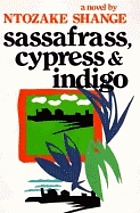I've read this novel about three artist sisters from South Carolina at least twice before. The first time I absolutely loved it, and the second time I was a little cooler. This time--probably 15 years after the last reading--I was in some ways reading a whole different book. Being in my teens and twenties for the first two readings, I was focused entirely on weaver Sassafrass, musician Indigo, and especially dancer Cypress. Now that I'm probably closer to mama Hilda Effania's age, I found her to be the most intriguing character.
While her daughters are gallivanting around the country with men and women, junkies and religious communities, midwives and babies and artists of all kinds Hilda Effania is writing her children letters, sometimes intolerant or ignorant, and other times wise or loving. She's the most contradictory of the three, and the most deep even though she probably has the fewest scenes, and the story is never told from her point-of-view.
Just so's you know more about the story, it's magic realism centered on an African-American family headed by a single mother. Each of the talented daughters goes off and does her own thing trying to honor her ancestors and also be true to her own self. For about the first half of the book we follow 12-year-old Indigo as she navigates the onset of menstruation, gang membership, saying goodbye to her childhood doll companions, and learning to communicate instead with a violin. It takes a while to get used to her, and then we don't hear anything from her until the very end. The second half of the book is about Cypress and Sassafrass dealing with love and their artistic vocations and spirits.
